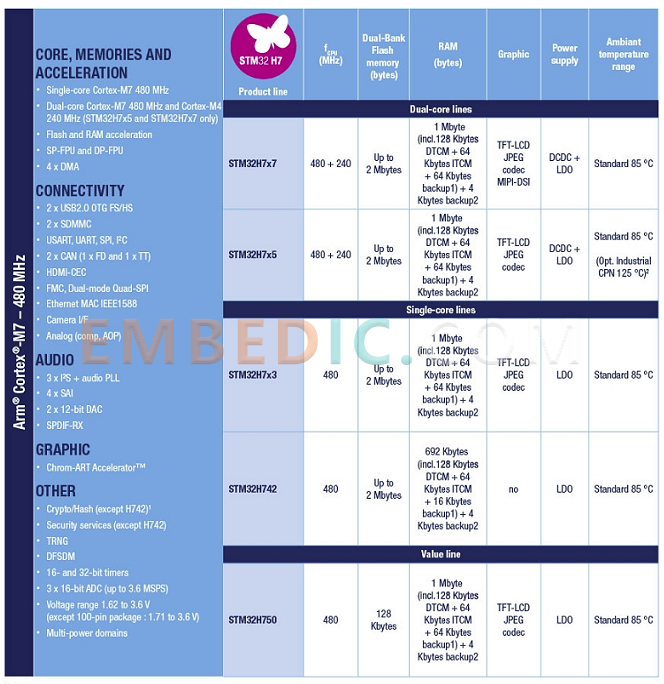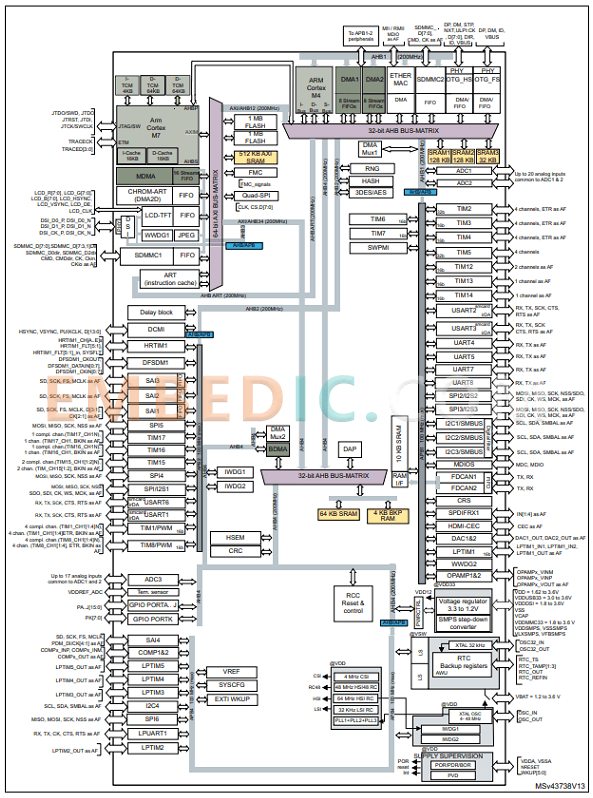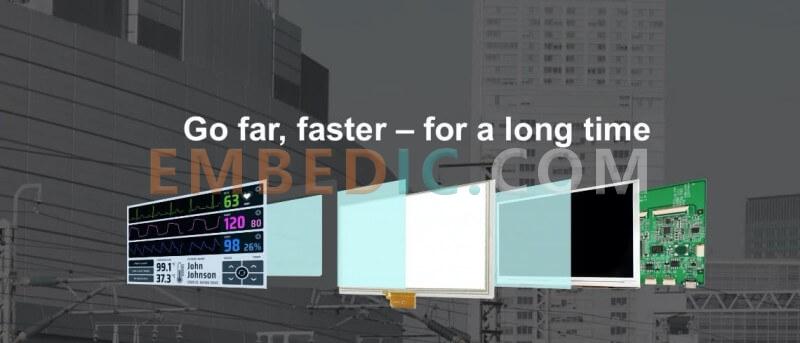Riverdi, a practitioner of the TouchGFX development framework, showcased its STM32 embedded display product line at the recent Display Week display week event. The product is a 1280 x 800 resolution, 800 nits brightness 10.1" IPS display paired with an STM32H7 board.
1. Product Description: ARM Cortex-M core microcontroller
2. Product features: high performance, low cost, low power consumption, cuttable
3. Development company: STMicroelectronics Group
4. Application areas: Embedded development
Mainstream products (STM32F0, STM32F1, STM32F3), ultra-low-power products (STM32L0, STM32L1, STM32L4, STM32L4+), high-performance products (STM32F2, STM32F4, STM32F7, STM32H7)
ST ultra-low power ARM Cortex™-M3 microcontrollers
Based on the ultra-low-power ARM Cortex-M4 processor core, the STM32L family offers industry-leading power-saving performance using two of ST's unique energy-saving technologies: a 130nm dedicated low leakage current manufacturing process and an optimized energy-saving architecture. The family is part of ST's robust 32-bit STM32 microcontroller family of more than 200 products, which share most of the pins, software and peripherals, providing developers with maximum design flexibility through compatibility.
ST Ultra-low Power ARM Cortex™-M0 Microcontrollers
Based on the ultra-low-power ARM Cortex-M0 processor core, the STM32F0 family incorporates enhanced technology and features targeting ultra-low cost budget applications. This family of microcontrollers bridges the performance gap between devices with 8- and 16-bit microcontrollers and those with 32-bit microcontrollers, enabling advanced and sophisticated functionality on affordable user end products.
The STM32H7 is at the top of the High Performance category. It is a solitary or dual-core microcontroller, consisting of a 480MHz Cortex M7 and an added 240MHz Cortex M4 core for the dual core variations. The High Performance classification provides the highest efficiency in code implementation and also data transfers.
It also has the highest possible performance and also most sophisticated peripherals in the STM32 family members. Figure 1 summarizes the highlights of the numerous participants of the STM32H7 offerings. Figure 2 reveals the internal block diagram of the premium dual core STM32H757.

Figure 1

Figure 2
2.1. Small-volume procurement issues
Display procurement remains the most expensive and complex part of an embedded system development project, especially for small quantities. Display vendors often do not know how to execute orders of only 1,000 or 10,000 units, or cannot guarantee long-term small-volume delivery. As a result, small businesses either take on the significant financial risk of ordering large quantities or the development risk of being forced to redesign their systems because the desired product is discontinued. However, GUIs are growing in popularity and are more prevalent than ever before.
GUI development frameworks such as TouchGFX have greatly simplified the task of application development and lowered the barrier to entry for enterprises. The challenge in front of embedded developers is how to deal with display manufacturers, as the display manufacturing process prefers high-volume orders.
2.2. Create an ecosystem to address development challenges
ST introduced the X-NUCLEO-GFX01M2 and X-NUCLEO-GFX02Z1 to meet this challenge. These two display expansion boards are designed with the intention of helping enterprises reduce display bill of materials costs, in addition to their target applications include smaller screen development projects. As a result, Riverdi fills a gap in the market for embedded systems without an HD screen by providing an HD screen on an out-of-the-box development tool.
To overcome this challenge, ST and Riverdi have partnered to ensure that the STM32 embedded display supports the TouchGFX Designer software and can run the TouchGFX board support package, allowing developers to run demos with a single mouse click and even develop graphical applications with tools such as STM32CubeMX and STM32CubeIDE, among others. tools to develop graphical applications.
3.1. Make HD displays ubiquitous
Riverdi chose the dual-core STM32H747XIH6 microcontroller with 2 MB of integrated flash and 1 MB of RAM. The embedded display system also provides up to 64 MB of external QSPI flash memory and 8 MB of external SDRAM memory for graphics data and frame buffering, respectively. Riverdi chose this MCU because of its dual-core architecture, which means it can drive two screens. As a result, the company added a RiBUS port to simplify multi-screen embedded system design, which is rare in the industry. Finally, Riverdi enhanced the board's immunity to electromagnetic interference to help customers meet regional certification requirements.

3.2. Help engineers customize designs on demand
Engineers can customize the STM32 embedded display to their actual needs, choosing whether to use a touch screen, a vacuum full lamination screen or a semi-lamination screen with gaps, a touch-sensitive shape, and whether to install a frame. This should therefore help development teams to determine the system budget exactly according to their respective needs. The company also offers an STM32 evaluation board without a display.
The evaluation board comes with the Riverdi EVE4 display module, which supports Riverdi's 3.5-inch to 10.1-inch displays. As a result, designers seeking smaller screens can still bypass the market challenges encountered with small volume component purchases. In addition, Riverdi is also developing lower resolution STM32 embedded displays for the MIPI DSI interface.
Related News:
1、STM32F103RCT6 STMicroelectronics onboard resource introduction
2、STM32 Microcontroller detailed interpretation
3、STM32 Nucleo Shield display board to simplify the GUI design of ultra-low-power devices
Manufacturer: Texas Instruments
IC DGTL MEDIA SOC 337NFBGA
Product Categories: SOC
Lifecycle:
RoHS:
Manufacturer: Texas Instruments
IC DGTL MEDIA SOC 337NFBGA
Product Categories: SOC
Lifecycle:
RoHS:
Manufacturer: Texas Instruments
IC DSP FIXED-POINT 196NFBGA
Product Categories: DSP
Lifecycle:
RoHS:
Manufacturer: Texas Instruments
IC DSP FIX/FLOAT POINT 841FCBGA
Product Categories: DSP
Lifecycle:
RoHS:
Looking forward to your comment
Comment